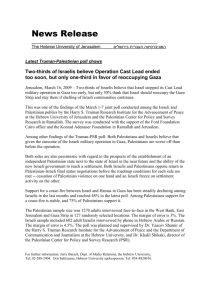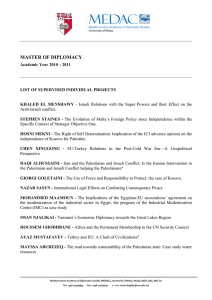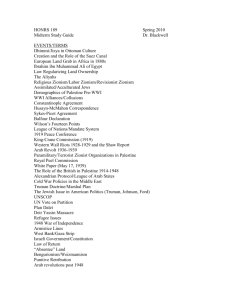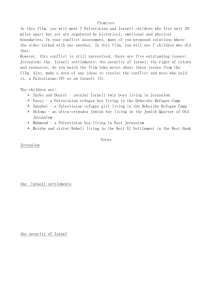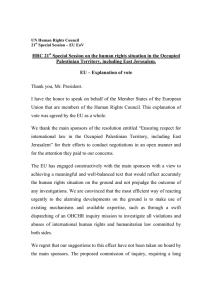A General Assembly United Nations Human Rights Council
advertisement
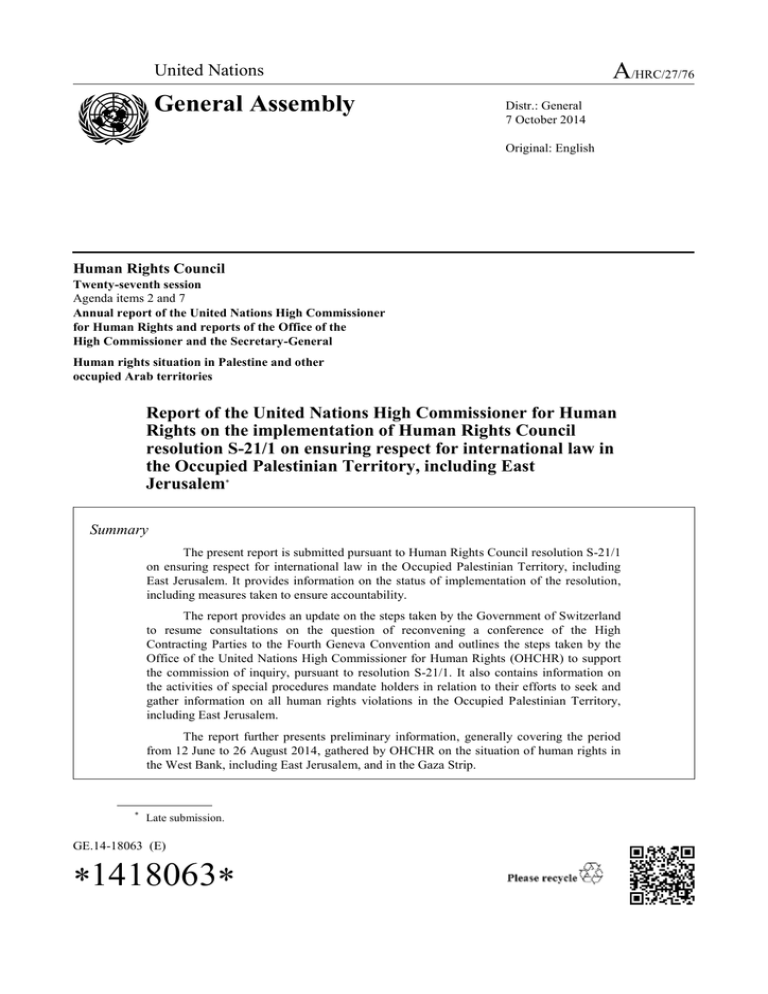
A/HRC/27/76 United Nations General Assembly Distr.: General 7 October 2014 Original: English Human Rights Council Twenty-seventh session Agenda items 2 and 7 Annual report of the United Nations High Commissioner for Human Rights and reports of the Office of the High Commissioner and the Secretary-General Human rights situation in Palestine and other occupied Arab territories Report of the United Nations High Commissioner for Human Rights on the implementation of Human Rights Council resolution S-21/1 on ensuring respect for international law in the Occupied Palestinian Territory, including East Jerusalem* Summary The present report is submitted pursuant to Human Rights Council resolution S-21/1 on ensuring respect for international law in the Occupied Palestinian Territory, including East Jerusalem. It provides information on the status of implementation of the resolution, including measures taken to ensure accountability. The report provides an update on the steps taken by the Government of Switzerland to resume consultations on the question of reconvening a conference of the High Contracting Parties to the Fourth Geneva Convention and outlines the steps taken by the Office of the United Nations High Commissioner for Human Rights (OHCHR) to support the commission of inquiry, pursuant to resolution S-21/1. It also contains information on the activities of special procedures mandate holders in relation to their efforts to seek and gather information on all human rights violations in the Occupied Palestinian Territory, including East Jerusalem. The report further presents preliminary information, generally covering the period from 12 June to 26 August 2014, gathered by OHCHR on the situation of human rights in the West Bank, including East Jerusalem, and in the Gaza Strip. * Late submission. GE.14-18063 (E) A/HRC/27/76 2 A/HRC/27/76 Contents Paragraphs Page I. Introduction ............................................................................................................. 1–2 3 II. Status of implementation of resolution S-21/1 ........................................................ 3–14 3 III. A. Conference of High Contracting Parties to the Fourth Geneva Convention ... 3–6 3 B. Establishment of the commission of inquiry................................................... 7–9 4 C. Activities of special procedures mandate holders ........................................... 10–14 4 Monitoring by the Office of the United Nations High Commissioner for Human Rights ................................................................... 15–29 5 A. Situation in the West Bank, including East Jerusalem .................................... 16–19 5 B. Situation in Gaza............................................................................................. 20–26 6 C. Promoting accountability for violations of international humanitarian and human rights law ..................................................................................... 27–29 8 3 A/HRC/27/76 I. Introduction 1. The present report is submitted pursuant to Human Rights Council resolution S21/1, adopted at the twenty-first special session of the Council on 23 July 2014. The report addresses the status of implementation of resolution S-21/1, notably with regard to the reconvening of the conference of High Contracting Parties to the Fourth Geneva Convention relative to the Protection of Civilian Persons in Time of War of 12 August 1949 (the Convention), support to the Commission of Inquiry established pursuant to resolution S-21/1 and the relevant activities by special procedures mandate holders. 2. The report also presents preliminary information gathered, primarily between June and August 2014, by the Office of the United Nations High Commissioner for Human Rights (OHCHR), on violations of international human rights law and international humanitarian law in the West Bank, including East Jerusalem and in the Gaza Strip. It also includes information available as of August 2014 on accountability measures relating to such violations. II. Status of implementation of resolution S-21/1 A. Conference of High Contracting Parties to the Fourth Geneva Convention 3. In resolution S-21/1, the Human Rights Council recommended that the Government of Switzerland promptly reconvene the conference of High Contracting Parties to the Convention on measures to enforce the Convention in the Occupied Palestinian Territory, including East Jerusalem, and to ensure its respect in accordance with article 1 common to the four Geneva Conventions (para. 11). On 12 August 2014, by note verbale to the Permanent Mission of Switzerland to the United Nations at Geneva, OHCHR requested information regarding the steps taken by the Government of Switzerland in that regard. 4. By note verbale dated 25 August 2014, the Permanent Mission of Switzerland stated that it had received two letters, from the President of the State of Palestine, dated 9 July 2014, and from the Foreign Minister of the State of Palestine, dated 22 July 2014, regarding the application of the Convention in the Occupied Palestinian Territory. Switzerland noted that, on 22 July 2014, it had sent the two letters to the High Contracting Parties, informing them of its intention, as the depositary of the Convention, to resume the consultations, which had been suspended in 2011, on the question of reconvening the conference of the High Contracting Parties. 5. Switzerland emphasized that, as the depositary of the Convention, it could only convene such conference if the High Contracting Parties so wished, but that it would act as facilitator and lead the consultation in a spirit of impartiality. It also suggested that any conference should be inclusive and focus on the object of the Convention, namely the humanitarian needs and protection of the civilian population affected by the conflict. 6. On 28 July 2014, with reference to General Assembly resolution 64/80 and Human Rights Council resolution S-21/1, Switzerland initiated consultations with High Contracting Parties to ascertain the existence of a critical mass of support to engage in a conference of the High Contracting Parties on compliance with the Convention in the Occupied Palestinian Territory. It approached a representative sample of more than 40 parties to the Convention, as well as international organizations, including the International Committee of the Red Cross, stating its readiness to engage bilaterally with any other party which so 4 A/HRC/27/76 wished. Parties were invited to submit their input regarding the format, themes and expected results of such a conference by early September 2014, which would be reflected in a second round of consultations. Switzerland noted that the process would enable the High Contracting Parties to make a fully informed decision regarding any eventual reconvening of the conference of the High Contracting Parties. B. Establishment of the commission of inquiry 7. In resolution S-21/1, the Human Rights Council decided to urgently dispatch an independent, international commission of inquiry, to be appointed by the President of the Council, to the Occupied Palestinian Territory, including East Jerusalem. The commission was mandated to, inter alia, investigate all violations of international humanitarian law and international human rights law in the Occupied Palestinian Territory, including East Jerusalem, particularly in the occupied Gaza Strip, in the context of the military operations conducted since 13 June 2014, whether before, during or after, with a view to avoiding and ending impunity and ensuring that those responsible are held accountable, and on ways and means to protect civilians against any further assaults (para. 13). 8. On 11 and 25 August 2014, the President of the Human Rights Council appointed William Schabas (Canada) as Chair, and Doudou Diène (Senegal) and Mary McGowan Davis (United States of America) as members of the commission of inquiry.1 9. The commission of inquiry will be operational once its secretariat has been established. On 30 July 2014, OHCHR advertised seven temporary posts for that purpose, and recommendations of candidates for core posts were submitted to the High Commissioner during the last week of August and the first week of September. Several secretariat staff members have been selected. The commission convened its first meeting and held briefings in Geneva in September 2014. It will undertake approximately six weeks of field visits, starting as soon as possible, and return to Geneva for two weeks in March 2015 to finalize and submit its report to the Human Rights Council at its twenty-eight session. C. Activities of special procedures mandate holders 10. The Human Rights Council requested all relevant special procedures mandate holders to urgently seek and gather information on all human rights violations in the Occupied Palestinian Territory, including East Jerusalem (resolution S-21/1, para. 12). 11. At the twenty-first special session of the Human Rights Council, the Special Rapporteur on the situation of human rights in the Palestinian territories occupied since 1967 delivered a statement on behalf of the Coordination Committee of the Special Procedures of the Human Rights Council.2 In the statement, the special procedures mandate holders urged prompt, independent and effective investigations into all allegations of violations of international humanitarian and human rights law, and offered the independent human rights expertise of the respective mandate holders to assist in the conduct of those investigations. The mandate holders also requested unhindered access to all affected areas and cooperation by the respective Governments of Israel and of the State of Palestine. 1 2 See www.ohchr.org/en/NewsEvents/Pages/DisplayNews.aspx?NewsID=14934&LangID=E and http://unispal.un.org/UNISPAL.NSF/0/F3F05FA912746BB285257D3F0070BEFD. See text of statement at www.ohchr.org/EN/NewsEvents/Pages/DisplayNews.aspx? NewsID=14894&LangID=E. 5 A/HRC/27/76 12. The State of Palestine extended a standing invitation to all special procedures mandate holders, and communicated its acceptance of a country visit by the Special Rapporteur on violence against women and proposed that it take place in January 2015. The Special Rapporteur on the situation of human rights in the Palestinian territories occupied since 1967 formally requested the respective Governments of Israel and of the State of Palestine to grant him access to the Occupied Palestinian Territory in September 2014. The Government of the State of Palestine responded positively to the request in a note verbale dated 27 August 2014. No response had been received from Israel as of the end of August 2014. 13. A wide array of civil society organizations submitted information to thematic special procedures mandate holders working in the areas of economic, social and cultural rights. The human rights concerns raised relate to the destruction of homes and essential infrastructure, the lack of safe shelter and overcrowded living conditions, due to mass displacement, electricity blackouts and shortages of food, drinking water and medical supplies. The impact on the population in Gaza, particularly on the most vulnerable, including children, persons with disabilities and older men and women, continues to be of serious concern. 14. Summaries of relevant special procedure communications sent to the countries concerned can be found in the joint communications report of special procedures. III. Monitoring by the Office of the United Nations High Commissioner for Human Rights 15. The field presence of OHCHR in the Occupied Palestinian Territory continued to monitor the human rights and humanitarian law situation in the West Bank, including East Jerusalem, and in the Gaza Strip during the period from 12 June to 26 August 2014, when an open-ended ceasefire between the parties to the hostilities entered into force. The overwhelming scale of the monitoring demands and the prevailing security situation in Gaza made it impossible to undertake a complete verification and analysis of all the information received in the time available for the preparation of the present report. As such, all data and findings contained herein are preliminary and subject to further verification. A. Situation in the West Bank, including East Jerusalem 16. Following the kidnapping of three Israeli youths on 12 June 2014, the Israeli Security Forces launched extensive search and arrest operations in the West Bank, including East Jerusalem, especially in the Hebron area. Reportedly, between 1,100 and 1,500 Palestinians were detained, including 27 members of the Palestinian Legislative Council. Restrictions on the freedom of movement of Palestinians and damage to property were reported during the operations. The bodies of the three youths were discovered on 30 June. Shortly thereafter, the Israeli authorities resumed the practice of punitive house demolitions, which had been suspended in 2005, partially demolishing the homes of two Palestinians suspected, but not convicted, of the murders. Six relatives of the suspects, including two children, were consequently displaced. 3 In August 2014, complete courtsanctioned demolitions were carried out of the homes of the two suspects. Furthermore, on 31 August, the Israeli Civil Administration declared 988 acres (3,799 dunums) of 3 6 See United Nations Office for the Coordination of Humanitarian Affairs (OCHA), Protection of Civilians Weekly Report, 24–30 June 2014, available from www.ochaopt.org/reports.aspx?id=104. A/HRC/27/76 Palestinian land, south of Bethlehem, as State land, reportedly “in response” to the kidnapping and murders.4 17. Amid the climate of incitement and racial hatred following the discovery of the three murdered Israeli youths, a 16-year-old Palestinian boy from Shu’fat, East Jerusalem, was found murdered on 2 July, in an apparent revenge killing. Israeli police arrested three suspects shortly afterwards, who have since been charged and are awaiting trial. 18. Clashes between Palestinians and Israeli Security Forces took place throughout the reporting period. In the first wave between 12 and 30 June 2014, in the context of extensive search and arrest operations, seven Palestinians were killed and more than 780 injured. From 2 to 7 July 2014, following the murder of the Palestinian boy, some 570 Palestinians were reportedly injured by Israeli Security Forces, including 31 people injured by live fire. Seventeen Israeli Security Force officers were reportedly also injured in the violence. Clashes between Palestinians and Israeli Security Forces in the West Bank continued after Israel launched its military operation in Gaza on the night of 7 July, killing 12 Palestinians and injuring more than 1,000 people in the last two weeks of July alone. From 12 June to 26 August 2014, a total of 27 Palestinians were killed, including four children, and almost 3,000 were injured, including 980 people who were apparently hit by live ammunition.5 According to initial findings by OHCHR, in a number of cases, there did not appear to be any imminent lethal threat posed by those killed by the Israeli Security Forces. The high number of killings and injuries during the reporting period give rise to serious concerns over excessive use of force by Israeli Security Forces. 6 19. The serious deterioration in the situation in the West Bank, including East Jerusalem, during the reporting period has been largely overshadowed by events in Gaza, but remains grave cause for concern. With regard to violations of international humanitarian and human rights law, the actions of the Israeli forces raise various concerns: excessive use of force, including use of live ammunition against unarmed demonstrators; arrest and detention of hundreds of Palestinians, including members of the Palestinian Legislative Council, in violation of fair trial rights; and restrictions on the freedom of movement of Palestinians. Some actions by the Israeli authorities, especially in the Hebron area, may amount to collective punishment. B. Situation in Gaza 20. An increase in hostilities between Israel and Palestinian armed groups was already noted since early June 2014. During that month, the Israeli Defense Forces carried out targeted killings of six members of armed groups, which also resulted in the killing of one child and injury to three Palestinian civilians. Around 60 civilians were injured in Israeli airstrikes on targets across the Gaza Strip.7 The firing of rockets and mortars from Gaza towards Israel also increased noticeably. Three Israelis were reported injured in those 4 5 6 7 See “Israel appropriates massive tracts of West Bank land”, available from www.haaretz.com/news/ diplomacy-defense/.premium-1.613319. Source: OHCHR (fatalities) and OCHA (injuries). Note: The injured include those suffering from tear gas inhalation and requiring medical attention. There were reports of isolated incidents of Palestinians firing live ammunition towards Israeli Security Forces, although no injuries were reported. Source: OCHA, Protection of Civilians Weekly Reports, available from www.ochaopt.org/ reports.aspx?id=104.. 7 A/HRC/27/76 attacks.8 Furthermore a two-year-old Palestinian girl was killed, and one adult and four children were injured by rockets that apparently fell short and landed in Gaza. 9 21. Late on 7 July 2014, Israel launched a military operation in Gaza, code-named “Protective Edge”.10 The operation can be broken into three phases: a period of air, land and naval strikes, between 7 and 17 July; a ground operation by Israeli forces entering the Gaza Strip, from 18 July to 5 August, accompanied by continuing airstrikes; a period of alternating ceasefire and military strikes, until an indefinite ceasefire came into effect on 26 August. Between 8 July and 26 August, 5,830 missiles in 4,028 air raids, 16,507 artillery and tank projectiles and 3,494 naval shells were fired at targets in the Gaza Strip. During the same period, Palestinian armed groups fired 4,844 rockets and 1,734 mortars towards Israel, of which, at least 243 were intercepted by the Iron Dome anti-missile defence system.11 At least 31 more fell short and landed in Gaza. 22. According to preliminary data as of 9 September 2014,12 2,142 Palestinians were killed, between 7 July and 26 August, or died from injuries sustained during that period. Of those, 1,474 are believed to have been civilians, including 501 children and 257 women. Another 381 could either not be identified or their status has yet to be determined, while 287 members of armed groups are believed to have been killed. 13 According to Israeli media reports, as of 4 September 2014, at least four Israeli civilians, including one child, one foreign civilian in Israel, 66 Israeli soldiers and one person, whose status is not yet known, were killed during the reporting period.14 Dozens more Israelis, including at least six children, were directly injured by rockets, mortars or shrapnel.15 More than 180 Israeli soldiers were reportedly injured. 23. According to the Ministry of Health in Gaza, 11,100 Palestinians, including 2,088 women and 3,374 children, were injured between 7 July and 26 August 2014. Furthermore, during the same period, 18,080 housing units were totally destroyed or had become uninhabitable, leaving approximately 108,500 people homeless.16 As of 26 August 2014, approximately 479,000 Palestinians—more than a quarter of the entire population of 8 9 10 11 12 13 14 15 16 8 See www.jpost.com/Defense/Two-more-Gaza-rockets-fired-at-southern-Israel-after-hit-on-Sderotfactory-360872. Source: OHCHR. See https://twitter.com/IDFSpokesperson/status/486274187636396035; also www.idfblog.com/blog/ 2014/08/05/operation-protective-edge-numbers/. Source: United Nations Department of Security and Safety. Throughout the hostilities, OHCHR, in its capacity as leader of the Protection Cluster in the Occupied Palestinian Territory, compiled figures on fatalities . The methodology involved the compilation of initial reports of fatalities in the media and from other sources, which were then cross-checked and verified in collaboration with a number of international, Palestinian and Israeli partner organizations. Where possible, each individual’s name, age, sex, place of death as well as status (civilian or combatant) was determined and recorded. Multiple sources were cross-referenced, not only from media and various human rights organizations, but also information released by the Israeli Defense Forces and by the armed groups regarding the identity of combatants. Information from the Ministry of Health in Gaza was one, but not exclusive, source of information. Verification of the preliminary information was continuing through interviews, as the security situation eased, and preliminary data was being revised and updated. OHCHR updates the information daily and overall figures have been published on the OCHA website on behalf of the Protection Cluster. This fatality toll does not include the approximately 25 Palestinians reported killed by armed groups in Gaza since 21 August 2014 , for allegedly collaborating with Israel. See www.ochaopt.org/documents/ocha_opt_sitrep_04_09_2014.pdf; and www.jpost.com/OperationProtective-Edge/In-Memoriam-The-27-IDF-soldiers-who-gave-their-lives-to-protect-Israel-368493. See www.ochaopt.org/documents/ocha_opt_sitrep_27_08_2014.pdf. See OCHA documents in footnotes 16 and 17 above. A/HRC/27/76 Gaza—had been displaced, including approximately 289,109 people, who were sheltering in schools run by the United Nations Relief and Works Agency for Palestine Refugees in the Near East (UNRWA), 48,742 people in government shelters and at least 140,895 who were staying with relatives.17 24. OHCHR preliminary monitoring and external reports on the conduct of hostilities by the Israeli forces raised concerns under international law, including international humanitarian law and international human rights law. In particular, serious questions arose over the apparent failure to respect the principles of distinction, proportionality and precaution under international humanitarian law in attacks, including the targeting of civilian objects, leading to the killing of civilians; the targeting of apparent military objectives, with possible failure to take all necessary precautions; attacks which may fail the proportionality test; indiscriminate attacks impacting the civilian population and civilian objects without distinction, especially during the ground operations; attacks on schools, including the UNRWA schools that were used as shelters for internally displaced persons, in breach of the inviolability of United Nations premises; attacks on hospitals, ambulances and ambulance staff; and allegations of the use of Palestinians as human shields. 18 25. OHCHR preliminary monitoring and external reports on the conduct of Palestinian armed groups, including Hamas, during hostilities also raised human rights concerns and concerns under international humanitarian law. Of particular concern were the indiscriminate nature of attacks and the placing of weapons in UNRWA schools, in breach of the inviolability of United Nations premises. There were also reports of military objects placed in populated areas; killing of persons suspected of collaborating with Israel; and alleged violation of the freedom of movement and right to physical integrity of members of Fatah. In addition, Israeli authorities alleged that tunnels for military purposes had been constructed under civilian objects; rocket attacks were launched from densely populated areas; hospitals and ambulances were used for military purposes;19 and the use of human shields.20 OHCHR continues to work to verify those reports and allegations. 26. The scale of hostilities far exceeded that of previous hostilities in 2012 and in 2008– 2009, in terms of duration and fatalities, and have resulted in an unprecedented level of destruction in Gaza. It has not yet been possible to assess the longer term impact of the destruction on the enjoyment of economic, social and cultural rights by Palestinians, but it is seems clear that enormous effort will be necessary to rebuild basic infrastructure and deal with the psychosocial consequences of the traumatic events. C. Promoting accountability for violations of international humanitarian and human rights law 27. At this stage, it would be premature to even attempt to offer a comprehensive assessment of necessary accountability measures. Further information gathering, verification and analysis will be necessary in the coming months, before definite conclusions on violations and required accountability measures can be drawn. Current monitoring and investigation efforts are essential in order to establish the facts and pave the way for the establishment of such measures at the international level. Investigations and accountability measures by parties to the conflict, at the domestic level, are of critical 17 18 19 20 See www.ochaopt.org/documents/ocha_opt_sitrep_26_08_2014.pdf. See www.dci-palestine.org/documents/israeli-forces-use-palestinian-child-human-shield-gaza. See www.idfblog.com/blog/2014/07/28/hamas-uses-hospitals-ambulances-military-purposes/. See www.idfblog.com/blog/2014/08/20/new-declassified-report-exposes-hamas-human-shieldpolicy/. 9 A/HRC/27/76 importance. The adequacy of the measures taken at the domestic level will necessarily inform the measures taken at the international level. 28. OHCHR continues its monitoring activities in the Occupied Palestinian Territory and is verifying information which appears to indicate violations of international humanitarian law and international human rights law, including war crimes, during the reporting period, for presentation in future reports. It is expected that the commission of inquiry will undertake its own investigations in parallel. 29. The events that took place between June and August 2014, in the West Bank, including East Jerusalem, and in Gaza, saw both sides once again resorted to violence. Yet, respect for human rights and international law remains the only way to guarantee peace and justice for all. The primary responsibility for ensuring accountability, remedies for victims and ending impunity rests with both the Israeli and the Palestinian authorities. Serious shortcomings in the systems of accountability have been highlighted in the past by the Secretary-General, the High Commissioner for Human Rights and the Fact-finding mission on the Gaza conflict,21 with the latter recommending that the situation be referred to the International Criminal Court. Given the ongoing failure to ensure effective accountability, that recommendation remains relevant. Accountability for violations committed by both sides is an essential step towards restoring respect for human rights and ensuring nonrepetition of recurrent violent crises in the area. 21 10 See, inter alia, A/HRC/12/48, paras. 1773–1873; A/HRC/25/40, paras. 50–60; and A/68/502, paras. 29-47.

